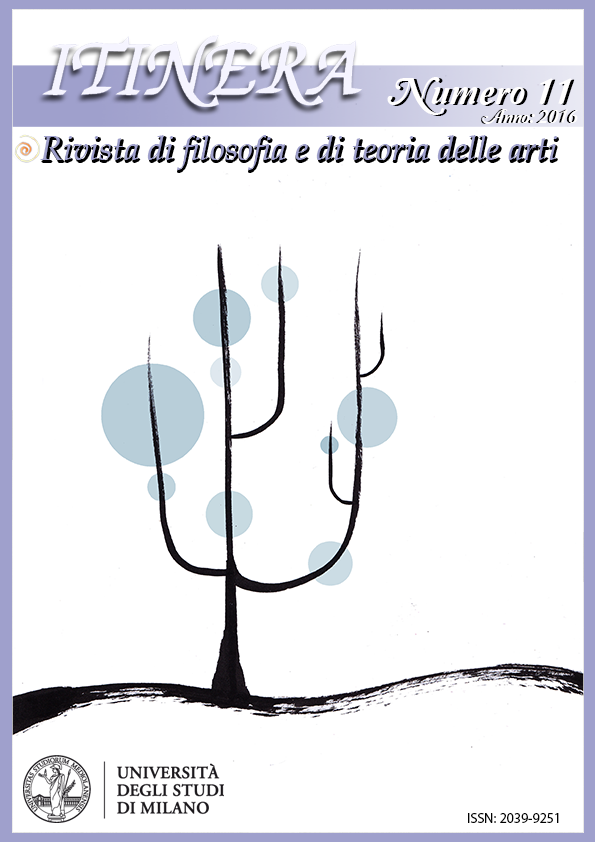Kirchner e Murnau: ricorrenze iconiche, tematiche e semantiche dalle arti figurative al cinema
DOI:
https://doi.org/10.13130/2039-9251/7420Abstract
German Expressionism has had from the beginning a multidisciplinary character and the works of the painters, pertaining to that current, have strongly influenced the filmmakers of the subsequent decade. More specifically, it is possible to find in some sequences of Nosferatu by Friedrich Wilhelm Murnau several formal features that have characterized the production of expressionist Ernst Ludwig Kirchner, as well as the direct quotation of some works of him, including The Red Tower in Halle, Two Women in the Street and Five Women in the Street. The reproduction in the frames of specific works of art, the image distortion, even the make-up of actors resume then aesthetic elements first developed by Murnau and are intended to convey to the viewer a sense of anxiety compared to the reality, to the contemporary society, to the city life, even manifesting an inner struggle, that has united Kirchner and Murnau itself.
Riferimenti bibliografici
BARRON, Stephanie, DUBE, Wolf-Dieter (a cura di), Espressionismo tedesco. Arte e società, (catalogo della mostra tenutasi a Venezia nel 1997-1998) Bompiani, Milano 1997.
BERTETTO, Paolo, MONTI, Cristina, Robert Wiene. Il Gabinetto del Dottor Caligari, Lindau, Torino 1999.
BERTETTO, Paolo, TOFFETTI, Sergio (a cura di), Incontro ai Fantasmi. Il cinema Espressionista, Centro Sperimentale di Cinematografia, Roma 2008.
CANTZ, Hatje, Kirchner, (Catalogo della mostra tenuta Francoforte sul Meno nel 2010), Städel Museum, Francoforte 2010.
CHIAPPINI, Rudy (a cura di), Ernst Ludwig Kirchner, (catalogo della mostra tenutasi a Lugano nel 2000), Skira Milano 2000.
CHIARINI, Paolo, L’espressionismo tedesco. Storia e struttura, Silvy edizioni, Scurelle 2011.
DELLE VACCHE, Angela, Art and Cinema. How Art Is Used in Film, University of Texas Press, Austin 1996.
EISNER, Lotte, The Haunted Screen (1952), University of California Press, Berkley-Los Angeles-Oxford 1994, p. 47.
ELSAESSER, Thomas, Weimar Cinema and After. German’s Historical Imaginary, Routledge, Londra-New York 2000, p. 232.
FREUD, Sigmund, Das Unheimliche, in Imago, Vienna 1919, vol. V.
KRACAUER, Siegfried, Da Caligari a Hitler. Una storia psicologica del cinema tedesco (1947), a cura di L. Quaresima, tr. it. di G. Baracco, C. Doglio, Lindau, Torino 2007.
LLOYD, Jill, German Expressionism. Primitivism and Modernity, Yale University Press, New Avedon-London 1991.
MINUZ, Andrea, Friedrich Wilhelm Murnau. L’arte di evocare fantasmi, Edizioni fondazione ente dello spettacolo, Roma 2010.
MOELLER, Magdalena M., SCOTTI, Roland, Ernst Ludwig Kirchner, (catalogo della mostra tenutasi a Milano nel 2002) Mazzotta, Milano 2002.
PINZLER, Hans H., Friedrich Wilhelm Murnau. Ein Melancholiker des Films, (catalogo della retrospettiva in concomitanza della Mostra del Cinema di Berlino nel 2003) Bertz, Berlino 2003.
WYE, Deborah, Kirchner and the Berlin Street, (catalogo della mostra tenutasi a New York nel 2008) Museum of Modern Art, New York 2008.
Dowloads
Pubblicato
Fascicolo
Sezione
Licenza
Gli autori che pubblicano su questa rivista accettano le seguenti condizioni:
1. Gli autori mantengono i diritti sulla loro opera e cedono alla rivista il diritto di prima pubblicazione dell'opera, contemporaneamente licenziata sotto una Licenza Creative Commons - Attribuzione - Condividi allo stesso modo 4.0 internazionale che permette ad altri di condividere l'opera indicando la paternità intellettuale e la prima pubblicazione su questa rivista.
2. Gli autori possono aderire ad altri accordi di licenza non esclusiva per la distribuzione della versione dell'opera pubblicata (es. depositarla in un archivio istituzionale o pubblicarla in una monografia), a patto di indicare che la prima pubblicazione è avvenuta su questa rivista.
3. Gli autori possono diffondere la loro opera online (es. in repository istituzionali o nel loro sito web) prima e durante il processo di submission, poiché può portare a scambi produttivi e aumentare le citazioni dell'opera pubblicata (Vedi The Effect of Open Access).





